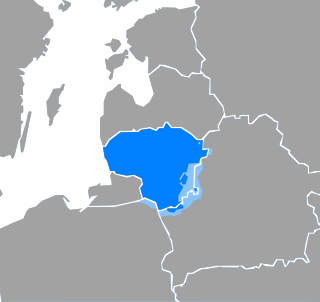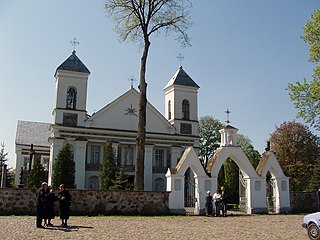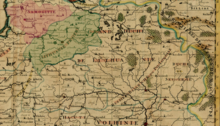
Vilnius, previously known in English as Vilna, is the capital of and largest city in Lithuania and the second-most-populous city in the Baltic states. The city's estimated July 2024 population was 605,270, and the Vilnius urban area has an estimated population of 708,627.

Lithuanian is an East Baltic language belonging to the Baltic branch of the Indo-European language family. It is the language of Lithuanians and the official language of Lithuania as well as one of the official languages of the European Union. There are approximately 2.8 million native Lithuanian speakers in Lithuania and about 1 million speakers elsewhere. Around half a million inhabitants of Lithuania of non-Lithuanian background speak Lithuanian daily as a second language.

The Grand Duchy of Lithuania was a sovereign state in northeastern Europe that existed from the 13th century, succeeding the Kingdom of Lithuania, to the late 18th century, when the territory was suppressed during the 1795 partitions of Poland–Lithuania. The state was founded by Lithuanians, who were at the time a polytheistic nation of several united Baltic tribes from Aukštaitija, which by 1440, became the largest European state controlling an area from the Baltic Sea in the north to the Black Sea in the south.

The coat of arms of Lithuania is a mounted armoured knight holding a sword and shield, known as Vytis. Since the early 15th century, it has been Lithuania's official coat of arms and is one of the oldest European coats of arms. It is also known by other names in various languages, such as Waykimas, Pagaunė in the Lithuanian language or as Pogonia, Pogoń, Пагоня in the Polish, and Belarusian languages. Vytis is translatable as Chase, Pursuer, Knight or Horseman, similar to the Slavic vityaz. Historically – raitas senovės karžygys or in heraldry – raitas valdovas.
The city of Vilnius, the capital and largest city of Lithuania, has an extensive history starting from the Stone Age. The city has changed hands many times between Imperial and Soviet Russia, Napoleonic France, Imperial and Nazi Germany, Interwar Poland, and Lithuania.

Vilnius Region[a] is the territory in present-day Lithuania and Belarus that was originally inhabited by ethnic Baltic tribes and was a part of Lithuania proper, but came under East Slavic and Polish cultural influences over time.

Vilnius District Municipality is one of the 60 municipalities in Lithuania. It surrounds the capital city of Vilnius on three sides. The municipality is also bordered by Trakai district and Elektrėnai municipality in the west, Astravyets and Ashmyany districts of Belarus in the east, Širvintos, Molėtai and Švenčionys districts in the north and Šalčininkai district in the south.

Trakai District Municipality is one of 60 municipalities in Lithuania.

Šalčininkai District Municipality is one of 60 district municipalities in Lithuania. The municipality is part of the Vilnius County and is located in southeastern Lithuania, next to the Belarus–Lithuania border. The south-eastern border of the municipality with Belarus includes a distinctive salient of Lithuanian territory, known as the Dieveniškės appendix, almost completely surrounded by Belarus.

The Catholic Church in Lithuania is part of the worldwide Catholic Church, under the spiritual leadership of the Pope in Rome. Lithuania is the world's northernmost Catholic majority country. Pope Pius XII gave Lithuania the title of "northernmost outpost of Catholicism in Europe" in 1939.

The Vilnius Castle Complex is a group of cultural, and historic structures on the left bank of the Neris River, near its confluence with the Vilnia River, in Vilnius, Lithuania. The buildings, which evolved between the 10th and 18th centuries, were one of Lithuania's major defensive structures.

The Vilnius Voivodeship was one of the Grand Duchy of Lithuania's voivodeships, which existed from the voivodeship's creation in 1413 to the destruction of the Lithuanian state in 1795. This voivodeship was Lithuania's largest, most politically and economically important.
Vytautas Merkys was a Lithuanian historian and a professor at Vilnius University.

Valkininkai is a historic town in Valkininkų (Valkininkai) eldership, Varėna District Municipality, Alytus County, Lithuania, located about 22 km (14 mi) northeast from Varėna and about 55 km (34 mi) southwest from Vilnius. At the Lithuanian census of 2001, its population was 238 and at the census of 2011 it was 229.

The Józef Zawadzki printing shop was a family-owned printing shop operating in Vilnius from 1805 to 1939. It was established by Józef Zawadzki who took over the failing printing press of Vilnius University established in 1575. It was one of the largest and most prominent printing presses in Vilnius. Until 1828, it had the exclusive rights to publish university publications. It published numerous books and periodicals in Polish, Latin, Lithuanian. It suffered difficulties due to Russification policies that closed Vilnius University in 1832 and banned Lithuanian press in 1864, but recovered after the restrictions were lifted due to the Russian Revolution of 1905. After World War I, it had difficulty competing with the larger printing presses in Poland. The press was sold to a Lithuanian company Spindulys in 1939 and nationalized by the Lithuanian Soviet Socialist Republic in 1940. After World War II, the press was transferred to the communist daily Tiesa.

The Lithuanian Citizens' Alliance was a political party in Lithuania.

Vilnius is the historic and present-day capital of Lithuania. Records of demographic measures go back to 1766, though the city itself has existed much longer. In recent days, the demographics have been heavily influenced by the war in neighboring Ukraine.

Gediminas' Cap was the most important regalia of the Lithuanian monarchs who ruled the Grand Duchy of Lithuania until the Union of Lublin in 1569. During the inaugurations of Lithuanian monarchs, Gediminas' Cap was placed on the monarch's heads by the Bishop of Vilnius in Vilnius Cathedral.

Robert Duchniewicz is a Lithuanian Polish politician. As of 2023, he is the vice-chairman of the Social Democratic Party of Lithuania and mayor of Vilnius District Municipality, which includes the rural districts around Vilnius and the Vilnius urban area's outskirts.























